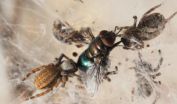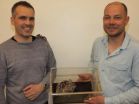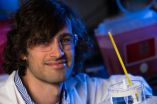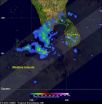(Press-News.org) The fact that the eight-legged creepy spider in some ways resembles humans is one of the surprising conclusions after researchers at Aarhus University and the Beijing Genomics Institute (BGI) succeeded in sequencing its genome.
However, it is more a discovery on an awesome scale. The sequencing has far greater significance for our future understanding of the spider's special properties.
"In brief, we've acquired a tool for everyone interested in spiders," say Kristian W. Sanggaard and Jesper S. Bechsgaard, Aarhus University. Together with Xiaodong Fang, BGI, they are the first authors of the study, which has been published in Nature Communications. By describing the spider genome, the researchers have roughly speaking drawn up its genetic map. This map can be used in future to navigate to and delve into different areas of the spider's functions – which will now be easier to describe.
What is a spider?
The researchers worked with two types of spiders, representing two of the three main groups in the spider family. One of these is a small velvet spider and the other is a tarantula.
The researchers succeeded in sequencing the velvet spider's genome, while there are still some unsolved gaps in the genetic map of the tarantula.
"The idea was that, by comparing their genetic makeup, we'd try to see whether we could say anything in general terms about what makes a spider a spider," says Kristian W. Sanggaard. However, it is almost 300 million years since the two types of spiders had a common ancestor, so the researchers could only find a limited number of similarities. "But we found a number of genes – about two to three hundred – that have only been found in these two types of spiders and not in other organisms. They could be candidates for genes specific to spiders," says Jesper S. Bechsgaard.
From overview to insight
The researchers were not content with simply mapping the spider genome. They also looked at the protein composition of two of the most interesting areas of the 'crawly cousins' – silk and venom production. By including the proteins, they did not restrict themselves to providing a map, but they also filled in details on two specific points. James Watson, who was awarded a Nobel Prize for describing the structure of the DNA strand, called genes the 'script' and proteins the 'actors'. By describing the proteins, the researchers thus demonstrated so to speak that their script works. Or – to keep to the map analogy – that the genetic map actually leads in the right direction. This is one of the only studies in which the proteins are described along with the genome. This was possible because the Aarhus researchers have some of the most advanced mass spectrometry equipment in the world for sequencing large numbers of proteins.
We can learn from spiders
The spider is a fantastic hunter. With the aid of its web, it can catch prey that are several times larger than itself, and it can also use its venom to subsequently kill the prey. Many researchers all over the world would like greater insight into areas such as how it makes its silk of thin, but incredibly strong thread, and how its venom works. By understanding the underlying mechanisms, we will possibly be able to convert this to industrial use in the long term, for purposes such as manufacturing biomaterials or developing medicine and pesticides. By describing the genome, the researchers have acquired a much better tool than they previously had for studying spiders. "People can select an aspect or feature of the spider they're interested in, and then utilise the 'genetic map' we published and which we ourselves have used to study silk and venom. This provides completely new opportunities for spider researchers," say the two Aarhus researchers. They personally intend to use the genome for further work with studies of the spider's digestive enzymes and immune system.
INFORMATION:The study of the spider genome was undertaken in collaboration between the Department of Bioscience, the Department of Molecular Biology and Genetics (MBG), the Interdisciplinary Nanoscience Centre (iNANO) and the Bioinformatics Research Centre (BIRC), all at Aarhus University, and the Beijing Genome Institute (BGI).
For more information, please contact
Jesper Smærup Bechsgaard
Department of Bioscience
Aarhus University
Denmark
+45 6168 4334
jesper.bechsgaard@biology.au.dk
Kristian Wejse Sanggaard
Department of Molecular Biology and Genetics and iNANO
Aarhus University
Denmark
+45 2374 1497
krs@mb.au.dk
Mapping the spider genome
What makes a spider a spider -- and what can we learn from spiders?
2014-05-07
ELSE PRESS RELEASES FROM THIS DATE:
Neural states affect learning
2014-05-07
Theta-band activity in hippocampus after an event seems to be crucial for learning. A study at the University of Jyväskylä also proved that the absence of theta facilitated learning a simple task while training during theta had no effect on learning.
Hippocampus is a brain structure that has a critical role in mammalian learning. The identification of different hippocampal states is based on the oscillatory properties of electrophysiological activity. Traditionally, rhythmic slow activity, theta, has been linked to attention, whereas transient bursts of synchronised neuronal ...
Third US National Climate Assessment reports our ecosystems are already changing
2014-05-07
The US Global Change Research Program released its Third National Climate Assessment (NCA) of the impacts of climate change on biodiversity and ecosystems this Tuesday, May 6. The NCA is the most comprehensive peer-reviewed analysis of climate change's impacts in the United States, informing Americans about the effects of climate change in their backyards.
"As an ecologist, you can't escape the effects of climate change on natural resources. We're observing climate impacts in nearly all natural and managed ecosystems," said Ecological Society of America President Jill ...
Breastfeeding promotes the growth of beneficial bacteria in the gut
2014-05-07
A number of studies have shown that breastfed babies grow slightly slower and are slightly slimmer than children who are fed with infant formula. Children who are breastfed also have a slightly lower incidence of obesity, allergies, diabetes and inflammatory bowel disease later in life. According to a new study by the National Food Institute and the University of Copenhagen this may be due to the fact that breastfeeding promotes the development of beneficial bacteria in the baby's gut.
"We have become increasingly aware of how crucially important a healthy gut microbial ...
Nanoscale heat flow predictions
2014-05-07
Physicists are now designing novel materials with physical properties tailored to meet specific energy consumption needs. Before these so-called materials-by-design can be applied, it is essential to understand their characteristics, such as heat flow. Now, a team of Italian physicists has developed a predictive theoretical model for heat flux in these materials, using atom-scale calculations. The research, carried out by Claudio Melis and colleagues from the University of Cagliary, Italy, is published in EPJ B. Their findings could have implications for optimising the ...
Researchers use DNA to build tool that may literally shine light on cancer
2014-05-07
Bioengineers at the University of Rome Tor Vergata and the University of Montreal have used DNA to develop a tool that detects and reacts to chemical changes caused by cancer cells and that may one day be used to deliver drugs to tumor cells.
The researchers' nanosensor measures pH variations at the nanoscale – how acidic (a higher pH level) or alkaline (a lower pH level) it is. Many biomolecules, such as enzymes and proteins, are strongly regulated by small pH changes. These changes affect in turn biological activities such as enzyme catalysis, protein assembly, membrane ...
Sleep researchers at SRI International identify promising new treatment for narcolepsy
2014-05-07
MENLO PARK, Calif.—May 7, 2014—Neuroscientists at SRI International have found that a form of baclofen, a drug used to treat muscle spasticity, works better at treating narcolepsy than the best drug currently available when tested in mice.
According to the National Institute of Neurological Disorders and Stroke (NINDS), narcolepsy, a chronic neurologic disorder characterized by excessive daytime sleepiness, is not a rare condition, but is under-recognized and under-diagnosed. It is estimated to impact 1 in 2,000 people worldwide.
In back-to-back papers published in ...
Argentina yields 3 new tarantula species
2014-05-07
A team of scientists from the Universidad de La República, Uruguay discovered three native to northern Argentina new species of the engaging spider group of the tarantulas. The study describing the newly found tarantulas was published in the open access journal ZooKeys.
The often hairy and very large spiders known as tarantulas are one of the most famous arachnid groups. Despite their ill fame as vicious killers most tarantulas are harmless to humans. Most tarantulas long lifespans, females can live between 15 and 30 years, which makes them a preferred pet for spider ...
A hydrogel that knows when to go
2014-05-07
HOUSTON – (May 7, 2014) – Rice University bioengineers have created a hydrogel that instantly turns from liquid to semisolid at close to body temperature – and then degrades at precisely the right pace.
The gel shows potential as a bioscaffold to support the regrowth of bone and other three-dimensional tissues in a patient's body using the patient's own cells to seed the process.
The hydrogel created in the lab of Rice bioengineer Antonios Mikos is a liquid at room temperature but, when injected into a patient, becomes a gel that would fill and stabilize a space while ...
NASA sees system 91B making landfall in southwestern India
2014-05-07
A tropical low was affecting southern India and Sri Lanka on May 6 at 0809 UTC when the Tropical Rainfall Measuring Mission satellite called TRMM flew above it. By May 7, System 91B moved over southwestern India and became less organized.
TRMM's Precipitation Radar revealed that rain was falling at a rate of 66 mm (2.6 inches) per hour in the stormy area south of India (5.2 north latitude and 77.1 east longitude). TRMM PR saw the tallest thunderstorm towers over Sri Lanka where heights were pushing to altitudes above 13 km (8 miles).
On May 7 at 12:30 UTC/8:30 a.m. ...
Perceived age and weight discrimination worse for health than perceived racism and sexism
2014-05-07
TALLAHASSEE, Fla. — Perceived age and weight discrimination, more than perceived race and sex discrimination, are linked to worse health in older adults, according to new research from the Florida State University College of Medicine.
The findings are part of a study measuring changes in health over a four-year period and published in the American Journal of Geriatric Psychiatry.
"Our previous research showed that perceived discrimination based on body weight was associated with risk of obesity. We wanted to see whether this association extended to other health indicators ...
LAST 30 PRESS RELEASES:
Recycling a pollutant to make ammonia production greener
Common institutional ownership linked to less aggressive business strategies in Chinese firms
Energy and regional factors drive carbon price volatility in China’s emissions trading markets
Researchers from NUS Medicine and the Institute of Mental Health detect early brain changes linked to future psychosis development
Cryopreserved vs liquid-stored platelets for the treatment of surgical bleeding
Cost-effectiveness of cryopreserved vs liquid-stored platelets for managing surgical bleeding
Adaptive Kalman filter boosts BDS-3 navigation accuracy in challenging environments
Home-based monitoring could transform care for patients receiving T-cell redirecting therapies
Listening to the 'whispers' of electrons and crystals: A quantum discovery
Report on academic exchange (colloquium) with Mapua University
Sport in middle childhood can breed respect for authority in adolescence
From novel therapies to first-in-human trials, City of Hope advances blood cancer care at the American Society of Hematology (ASH) annual conference
Research aims to strengthen the security of in-person voting machines
New study exposes hidden Alzheimer’s 'hot spots' in rural Maryland and what they reveal about America’s growing healthcare divide
ASH 2025: Study connects Agent Orange exposure to earlier and more severe cases of myelodysplastic syndrome
ASH 2025: New data highlights promise of pivekimab sunirine in two aggressive blood cancers
IADR elects George Belibasakis as vice-president
Expanding the search for quantum-ready 2D materials
White paper on leadership opportunities for AI to increase employee value released by University of Phoenix College of Doctoral Studies
ASH 2025: New combination approach aims to make CAR T more durable in lymphoma
‘Ready-made’ T-cell gene therapy tackles ‘incurable’ T-cell leukemia
How brain activity changes throughout the day
Australian scientists reveal new genetic risk for severe macular degeneration
GLP-1 receptor agonists likely have little or no effect on obesity-related cancer risk
Precision immunotherapy to improve sepsis outcomes
Insilico Medicine unveils winter edition of Pharma.AI, accelerating the path to pharmaceutical superintelligence
Study finds most people trust doctors more than AI but see its potential for cancer diagnosis
School reopening during COVID-19 pandemic associated with improvement in children’s mental health
Research alert: Old molecules show promise for fighting resistant strains of COVID-19 virus
Journal of Nuclear Medicine Technology supplement highlights advances in theranostics and opportunities for growth
[Press-News.org] Mapping the spider genomeWhat makes a spider a spider -- and what can we learn from spiders?





